| Srl | Item |
| 1 |
ID:
147990
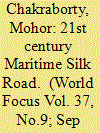

|
|
|
|
|
| Summary/Abstract |
The 21st Century Maritime Silk Road (MSR) is a cause for major concern in New Delhi as it provides a basis for Beijing to increase its geo-strategic footprint in the Indian Ocean. Notwithstanding the Chinese posture of allaying India’s concerns with respect to the massive outreach and implications of MSR, calling upon its neighbour to join the effort with a “friendly, open, cooperative attitude”, New Delhi has, naturally been cautious and calculative in making headway on the issue. Although Beijing had invited New Delhi to join the project in 2014, the Indian response has been negative.
|
|
|
|
|
|
|
|
|
|
|
|
|
|
|
|
| 2 |
ID:
157329
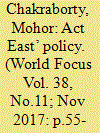

|
|
|
|
|
| Summary/Abstract |
The twin doctrines of ‘Act East’ and ‘Made in India’ have been significant contributions of the NDA-II Government’s foreign policy. In order to elevate India’s image as an attractive investment destination and strengthen its economic stature on the world stage, the most noteworthy endeavour has been the launching of the flagship ‘Make in India’ and the expanded umbrella of reforms. In this backdrop, greater emphasis has been laid on collaboration in defence technology, co-development and co-production at a time when the Indian defence sector is at the cusp of an inflexion point.
|
|
|
|
|
|
|
|
|
|
|
|
|
|
|
|
| 3 |
ID:
140609
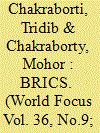

|
|
|
|
|
| Summary/Abstract |
The genesis of BRIC (Brazil-Russia-India-China, predecessor of present-day BRICS) as a multilateral grouping of the four developing or emerging economies can be traced back to September 2006, with the 61st Session of the United Nations General Assembly in New York, in a bid to explore measures of economic and political cooperation among the member-States. Officially, the organization came into existence in 2009, and with the inclusion of South Africa as the fifth member in April 2011, BRIC was re-christened BRICS. Till date, the BRICS member-states have held seven Summits and the latest in Ufa, Russia (July 2015) has been a watershed with the entry into force of the New Development Bank/BRICS Bank and the Contingent Reserves Arrangement. The BRICS Bank is heralded as an alternative to the World Bank-International Monetary Fund-led international economic architecture. However, it remains to be testified whether the BRICS Bank can evolve as a pulsating alternative to the WB-IMF-led financial system, though there is no way denying its establishment as a stepping stone for providing a predominantly South-South economic cooperative mechanism.
|
|
|
|
|
|
|
|
|
|
|
|
|
|
|
|
| 4 |
ID:
158238
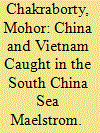

|
|
|
|
|
| Summary/Abstract |
Over the past four months, China has been swept by the ‘Xi wave’, stimulating a tide of concerns for its neighbours and ardent observers. Xi’s 203-minute speech at the 19th Congress of the CCP, followed subsequently by the CCP’s announcement of dropping the term limits for president (in February 2018) clearly herald the dawn of a “new era” of politics and power for a more assertive China, under the leadership of President Xi.
|
|
|
|
|
|
|
|
|
|
|
|
|
|
|
|
| 5 |
ID:
150605
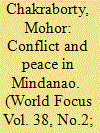

|
|
|
|
|
| Summary/Abstract |
The year 2014 will be commemorated in the history of Southeast Asia in general and the Philippines in particular as the year marking the almostpenultimate step towards the finale of a protracted separatist movement in the southern island of Mindanao, since the “Comprehensive Agreement on the Bangsamoro” was signed in Manila in March. Conceived as a nationalist struggle, aimed at the establishment of an autonomous homeland for the thirteen ethno-linguistic groups comprising the Philippine Muslims (‘Moros’), the historical roots of this movement run deep into the labyrinths of the colonial era. As a dominant group with a five-century old civilizational heritage, the Moros account for about 20% of the entire population of the Philippines and were originally concentrated in the southern provinces of the country.
|
|
|
|
|
|
|
|
|
|
|
|
|
|
|
|
| 6 |
ID:
164933
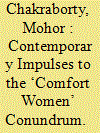

|
|
|
|
|
| Summary/Abstract |
The Second World Warbearstestimony to a gruesome eventrelated to the ‘comfortwomen’ system – which perpetrated organized sexual slavery on non-combatant women – “recruited” from different parts of the Asia-Pacific. The military brothels or “comfort stations” were established, managed and systematically run by the Japanese military, in full cognizance of the Imperial Government, between 1932 and 1945.
|
|
|
|
|
|
|
|
|
|
|
|
|
|
|
|
| 7 |
ID:
179587
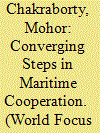

|
|
|
|
|
| Summary/Abstract |
India’s relations with the island-nation of Maldives has been on an upswing particularly since 2018, when President Ibrahim Mohamed Solih assumed office. As the present trends indicate, bilateral relations between New Delhi and Male are expected to take a “quantum jump” as both neighbours are committed to sustaining this positive impulse.
|
|
|
|
|
|
|
|
|
|
|
|
|
|
|
|
| 8 |
ID:
193397
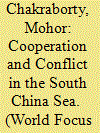

|
|
|
| 9 |
ID:
148111
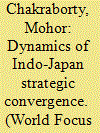

|
|
|
|
|
| Summary/Abstract |
In the annals of Indian foreign policy, the ‘Look East’ policy, practised for more than two decades, has provided the desired impetus to the country’s Southeast, East Asian and Asia-Pacific neighbourhood, also referred to as its “extended neighbourhood.” With the inauguration of the second tenure of the National Democratic Alliance/NDA government in May 2014, the ‘Look East’ Policy, re-christened ‘Act East’, has assumed new dynamism and vitality. In this respect, Japan has emerged as a fulcrum in India’s policy computations as validated by the Prime Minister of India, Narendra Modi’s selection of Japan as the first port of call (31 August–3 September 2014) outside the immediate neighbourhood. This visit was reciprocated by the Japanese Premier, Shinzo Abe in December 2015.
|
|
|
|
|
|
|
|
|
|
|
|
|
|
|
|
| 10 |
ID:
181510
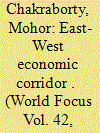

|
|
|
| 11 |
ID:
159949
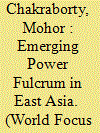

|
|
|
|
|
| Summary/Abstract |
Within the ambit of ‘Act East’, New Delhi’s determination to bring about significant, tangible changes as well as vigorously pursue a “proactive” foreign policy, has found its most significant extrapolation in the emphasis on boosting relations with major Indo-Pacific littoral powers like Japan, Indonesia, Malaysia, Vietnam, Australia, etc. In this context, the intensified engagement with regional maritime powers is a natural corollary of responding to the evolving strategic paradigm in the regional waters.
|
|
|
|
|
|
|
|
|
|
|
|
|
|
|
|
| 12 |
ID:
089172
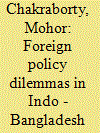

|
|
|
| 13 |
ID:
151129
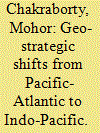

|
|
|
|
|
| Summary/Abstract |
The centre of gravity of global opportunities and challenges are shifting to the Indo-Pacific region from the Pacific-Atlantic. Explicitly identifying the region as a geostrategic priority for the US within the framework of the ‘pivot to Asia’ policy, the Obama administration shifted focus to the region across a wide range of issue areas. This policy may be viewed in the context of the burst of the myth of economic invincibility of the Western world in the aftermath of the global economic meltdown of 2008.
|
|
|
|
|
|
|
|
|
|
|
|
|
|
|
|
| 14 |
ID:
093328
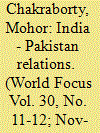

|
|
|
|
|
| Publication |
2009.
|
| Summary/Abstract |
The histroy of South Asian politics since the end of the second World War has been a kaleidoscope of at least threee major wars between India and Pakistan.
|
|
|
|
|
|
|
|
|
|
|
|
|
|
|
|
| 15 |
ID:
112995
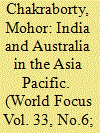

|
|
|
| 16 |
ID:
104607


|
|
|
| 17 |
ID:
100386
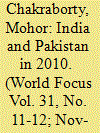

|
|
|
| 18 |
ID:
100008
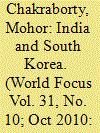

|
|
|
| 19 |
ID:
154017
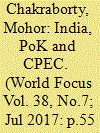

|
|
|
|
|
| Summary/Abstract |
India’s reservations to the CPEC since its initiation by Beijing as an integral part of OBOR (renamed B&RI) did not come as a great surprise to the international community, overridden by New Delhi’s concerns over sovereignty with respect to the Corridor passing through PoK. The recent boycott of the Inaugural B&RI Forum by India substantiated its sustained and unwavering posture on the issue.
|
|
|
|
|
|
|
|
|
|
|
|
|
|
|
|
| 20 |
ID:
138366
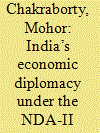

|
|
|
|
|
| Summary/Abstract |
The Prime Minister of India, Narendra Modi’s selection of Japan as the first port of call (31 August – 3 September 2014) outside the immediate neighbourhood has opened new vistas of cooperation and greater engagement between the two regional economic powers. Going by the plethora of Agreements signed and negotiations undertaken by the leaders of the two countries towards the intensification of bilateral economic engagement, the visit has indeed generated momentum in the trajectory of Indo-Japan ties. In particular, the convergence of the economic policies initiated by Narendra Modi and his Japanese counterpart, Shinzo Abe, namely “Modinomics” and “Abenomics” respectively, has affirmed New Delhi’s broader and stronger partnership with Tokyo for economic development, especially in the infrastructure sector. Given this cooperative premise, in the backdrop of the Comprehensive Economic Partnership Agreement (CEPA), that is operational between India and Japan since 2011, the manner in which the newly-installed Government in New Delhi steers its vehicle of economic diplomacy towards ‘Destination Japan’ gains import and hold much promise for future.
|
|
|
|
|
|
|
|
|
|
|
|
|
|
|
|